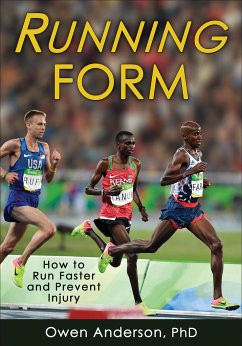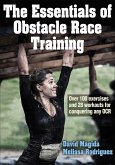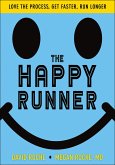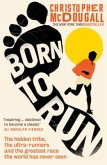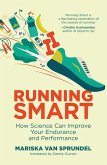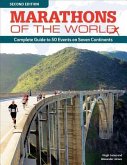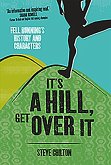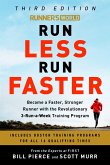- Broschiertes Buch
- Merkliste
- Auf die Merkliste
- Bewerten Bewerten
- Teilen
- Produkt teilen
- Produkterinnerung
- Produkterinnerung
Running Refined helps you make key improvements in form, leading to optimal running performance with less risk for injury.
Andere Kunden interessierten sich auch für
![The Essentials of Obstacle Race Training The Essentials of Obstacle Race Training]() David MagidaThe Essentials of Obstacle Race Training26,99 €
David MagidaThe Essentials of Obstacle Race Training26,99 €![The Happy Runner The Happy Runner]() David RocheThe Happy Runner22,99 €
David RocheThe Happy Runner22,99 €![Born to Run Born to Run]() Christopher McDougallBorn to Run10,99 €
Christopher McDougallBorn to Run10,99 €![Running Smart: How Science Can Improve Your Endurance and Performance Running Smart: How Science Can Improve Your Endurance and Performance]() Mariska Van SprundelRunning Smart: How Science Can Improve Your Endurance and Performance22,99 €
Mariska Van SprundelRunning Smart: How Science Can Improve Your Endurance and Performance22,99 €![Marathons of the World, Updated Edition Marathons of the World, Updated Edition]() Hugh JonesMarathons of the World, Updated Edition18,99 €
Hugh JonesMarathons of the World, Updated Edition18,99 €![It's a Hill, Get Over It It's a Hill, Get Over It]() Steve ChiltonIt's a Hill, Get Over It15,99 €
Steve ChiltonIt's a Hill, Get Over It15,99 €![Runner's World Run Less Run Faster Runner's World Run Less Run Faster]() Bill PierceRunner's World Run Less Run Faster19,99 €
Bill PierceRunner's World Run Less Run Faster19,99 €-
-
-
Running Refined helps you make key improvements in form, leading to optimal running performance with less risk for injury.
Hinweis: Dieser Artikel kann nur an eine deutsche Lieferadresse ausgeliefert werden.
Hinweis: Dieser Artikel kann nur an eine deutsche Lieferadresse ausgeliefert werden.
Produktdetails
- Produktdetails
- Verlag: Human Kinetics Publishers
- Seitenzahl: 232
- Erscheinungstermin: 23. Januar 2018
- Englisch
- Abmessung: 254mm x 180mm x 17mm
- Gewicht: 492g
- ISBN-13: 9781492510383
- ISBN-10: 1492510386
- Artikelnr.: 48253210
- Verlag: Human Kinetics Publishers
- Seitenzahl: 232
- Erscheinungstermin: 23. Januar 2018
- Englisch
- Abmessung: 254mm x 180mm x 17mm
- Gewicht: 492g
- ISBN-13: 9781492510383
- ISBN-10: 1492510386
- Artikelnr.: 48253210
Owen Anderson, PhD, is the coach and manager of some of the best runners in the world, including Cynthia Limo (silver medalist in the 2016 IAAF World Half Marathon Championship and first-ranked road racer in the world according to ARRS in 2016), Mary Wacera (world silver and bronze medalist in the 2014 and 2016 IAAF World Half Marathons), Monicah Ngige (two-time winner of the Cooper River Bridge Run 10K and champion of the 2017 Monterey Bay Half Marathon), Mary Wangui (victor at the 2017 Tulsa Run 15K), Iveen Chepkemoi (first in the 2017 AK Sotik Cross Country meeting in Kenya), and Gladys Kipsoi (winner of the 2017 Pittsburgh Half Marathon). Owen is the author of five books on running: Lactate Lift-Off,Great Workouts for Popular Races, Aurora, Running Science, and Running Form. He has written hundreds of articles on running for publications such as National Geographic Adventure, Runner's World, Shape, Men's Health, Peak Performance, Sports Injury Bulletin, and Running Research News. Owen has been a featured speaker at symposiums around the world, including seminars at City University, London; Osaka University; and the University of Tokyo. Owen, who speaks Swahili fluently, has traveled to Kenya on 25 different occasions to manage running camps, recruit elite athletes, and study the training habits and nutritional practices of elite Kenyan runners. During the summer, he hosts running camps throughout the United States. In his free time, Owen enjoys helping kids. He assisted in rescuing Kenyan children from the Tana Delta region during the savage conflicts of 2013 and has helped these young people resume their academic pursuits.
Introduction. The Importance of Form
Part I. Why Form Matters
Chapter 1. Traditional Views on Form
Chapter 2. Comparing Ordinary and Elite Runners
Chapter 3. The Elements of Form
Chapter 4. How Form Can Enhance Performance and Prevent Injury
Part II. Assessing and Improving Form
Chapter 5. Assessing Form
Chapter 6. Improving Foot-Strike Patterns
Chapter 7. Upgrading Shank Angle
Chapter 8. Shortening Stance Time and Increasing Cadence
Chapter 9. Improving Body Lean
Chapter 10. Promoting Positive Posture
Chapter 11. Putting It All Together
Part III. Form Factors for Running Success
Chapter 12. Running Shoes
Chapter 13. Performance, Gender, and Age-Based Differences in Form
Chapter 14. Running-Specific Strength Training
Chapter 15. Integrating Form Work Into Your Seasonal Training
References
Index
About the Author
Part I. Why Form Matters
Chapter 1. Traditional Views on Form
Chapter 2. Comparing Ordinary and Elite Runners
Chapter 3. The Elements of Form
Chapter 4. How Form Can Enhance Performance and Prevent Injury
Part II. Assessing and Improving Form
Chapter 5. Assessing Form
Chapter 6. Improving Foot-Strike Patterns
Chapter 7. Upgrading Shank Angle
Chapter 8. Shortening Stance Time and Increasing Cadence
Chapter 9. Improving Body Lean
Chapter 10. Promoting Positive Posture
Chapter 11. Putting It All Together
Part III. Form Factors for Running Success
Chapter 12. Running Shoes
Chapter 13. Performance, Gender, and Age-Based Differences in Form
Chapter 14. Running-Specific Strength Training
Chapter 15. Integrating Form Work Into Your Seasonal Training
References
Index
About the Author
Introduction. The Importance of Form
Part I. Why Form Matters
Chapter 1. Traditional Views on Form
Chapter 2. Comparing Ordinary and Elite Runners
Chapter 3. The Elements of Form
Chapter 4. How Form Can Enhance Performance and Prevent Injury
Part II. Assessing and Improving Form
Chapter 5. Assessing Form
Chapter 6. Improving Foot-Strike Patterns
Chapter 7. Upgrading Shank Angle
Chapter 8. Shortening Stance Time and Increasing Cadence
Chapter 9. Improving Body Lean
Chapter 10. Promoting Positive Posture
Chapter 11. Putting It All Together
Part III. Form Factors for Running Success
Chapter 12. Running Shoes
Chapter 13. Performance, Gender, and Age-Based Differences in Form
Chapter 14. Running-Specific Strength Training
Chapter 15. Integrating Form Work Into Your Seasonal Training
References
Index
About the Author
Part I. Why Form Matters
Chapter 1. Traditional Views on Form
Chapter 2. Comparing Ordinary and Elite Runners
Chapter 3. The Elements of Form
Chapter 4. How Form Can Enhance Performance and Prevent Injury
Part II. Assessing and Improving Form
Chapter 5. Assessing Form
Chapter 6. Improving Foot-Strike Patterns
Chapter 7. Upgrading Shank Angle
Chapter 8. Shortening Stance Time and Increasing Cadence
Chapter 9. Improving Body Lean
Chapter 10. Promoting Positive Posture
Chapter 11. Putting It All Together
Part III. Form Factors for Running Success
Chapter 12. Running Shoes
Chapter 13. Performance, Gender, and Age-Based Differences in Form
Chapter 14. Running-Specific Strength Training
Chapter 15. Integrating Form Work Into Your Seasonal Training
References
Index
About the Author
